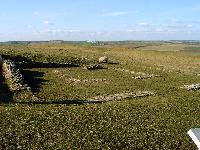The Celtic World
Iron Age, Celtic, Hill Forts in Britain
Maiden Castle
2 miles south of Dorchester, Dorset. Access off A354. Very well sign posted. (OS Map 194; ref SY 670885)
The largest, and most spectacular, hill fort in Britain is at Maiden Castle in Dorset. This site was in use thousands of years before the Celts arrived , however during the Iron age it became a major Celtic hill fort. The image shown here is from the English Heritage sign at the entrance to the hill fort and this identifies the site as having been in use from around 3800 BC. Maiden Castle covers an area of approximately 47 acres and truly has to be seen to be properly appreciated. Its name is believed to derive from the Celtic "Mai Dun" which means "Big Hill" and is more than appropriate.
, however during the Iron age it became a major Celtic hill fort. The image shown here is from the English Heritage sign at the entrance to the hill fort and this identifies the site as having been in use from around 3800 BC. Maiden Castle covers an area of approximately 47 acres and truly has to be seen to be properly appreciated. Its name is believed to derive from the Celtic "Mai Dun" which means "Big Hill" and is more than appropriate.
Occupied as an iron age settlement and hill fort from around 600BC, Maiden Castle grew to be one of the more significant Celtic sites in Britain. The layout of the fort gave the occupants an excellent defensive position, while allowing them to command the surrounding areas. As can be seen from the satellite photos of the region, this is a major earthenwork site.

The glory years for Maiden Castle are belived to have run from about 300BC until the arrival of the Romans in AD 43. Remains found at the site indicate it was home to a lively trading and farming community although exact estimates of the population are difficult. Given the size and location of Maiden Castle, it seems probable that it was home to the local chieftain.
The arrival of the Romans, under Vespasian, and their deadly efficient war machine spelt the end of the Durotriges tribe who occupied Maiden Castle in AD 43. After a bloody seige the Romans were victorious and the Celts were either sent back to Rome, taken as slaves or displaced to Durnovaria - modern day Dorchester.
It is a tribute to the military engineering skills of the invading Romans that, despite massive earth work defences (20m high in some places), the walls were finally breached. The images here lead to larger ones of approximately 95kb in size, while they can give you an idea of the work that went into the defence they fail to convey the true feeling of size. The Celtic warriors inside this fort must have felt invincible.
Please note: these images are released under the creative commons license that applies to this site. You are free to copy, distribute, display, and perform the work and to make derivative works as long as you give this site (http://celts.etrusia.co.uk/) credit and do not use this for commercial purposes. If you alter, transform, or build upon this work, you may distribute the resulting work only under a licence identical to this one.















